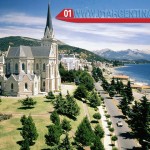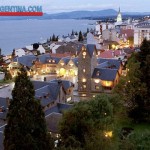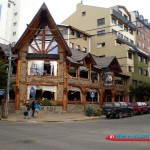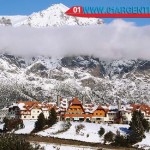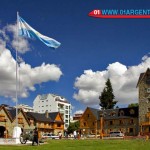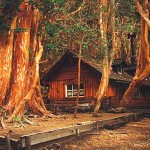San Carlos de Bariloche, or simply Bariloche is a city located in the province of Rio Negro, Argentina, and it is one of the main tourist city in Patagonia and all Argentina.
Bariloche is as well the most visited destination in Patagonia and in the Lake District, receives about 100,000 foreign tourists annually, among which stand out for their influx those from Chile and Brazil, followed by europeos.1 Argentina is the most populous city in the Patagonian Andes . It is located in the Nahuel Huapi National Park, southwest of the province of Rio Negro, near the Andes, on the southern shore of Lake Nahuel Huapi, 832 km from Viedma.
Nature reserves, including lakes, forests and mountains, and its outstanding ski resorts are the main attraction and economic livelihood of this city. The city has been considered by some sources as the second-level ski destination mundial.
Bariloche is also one of the most important scientific and technological poles of America, which houses the Centro Atomico Bariloche research, part of the National Atomic Energy Commission and the Balseiro Institute, National University of Cuyo, where he gives the race Physics and Mechanical Engineering and Nuclear. The city hosts INVAP, Argentina high-tech company that designs and builds nuclear reactors, ysatélites radars, among others.
HISTORY
Evidence of the existence of settlements Mahieu on the shores of Lake Nahuel Huapi, in the area now occupied by the city of Bariloche, before the arrival of explorers and settlers whites.5 During the Neolithic, the arrival of several groups occurs Aboriginal ethnic to the region of Nahuel Huapi. In particular there asentamientostehuelches, puelches, and pehuenches.
With the process of Araucanization and mainly in the seventeenth century these ethnic groups are absorbed by the Mapuche or Araucanian culture, coming from the south of Chile, and then intensified the Spanish colonization of Chile.
Between the mid-seventeenth and early eighteenth century, the area was subject to travel missionaries from Chile, including parents Diego Rosales, Nicolás Mascardi, Felipe and Juan José Guillelmo Laguna counted. The first white man who came to the region from the Atlantic is Dr. Francisco Moreno who was just 23 years old; arrived on January 22, 1876 and raised the Argentina flag on the shores of Nahuel Huapi.
On April 3, 1881 the first brigade, commanded by Lt. Col. Rufino Ortega, reached the lake Nahuel Huapi as part of the actions taken by the Argentine Army in post-Conquest of Desiertorealizadas by Conrado Villegas campaigns.
By the late nineteenth century, the largest settlement was located at the headwaters of the Limay River. The first non-native settler of the region was the bohemian José Tauschek6 who arrived with his family in 1892 from the area of the volcano Osornoen Chile, but an accident on his raft while navigating the river snatched life just eight years later. then 7To the settler Carlos Wiederhold Piwonka (a Chilean settlers from the area of Puerto Montt, Chile) and had established a warehouse in the area now occupied by the city and developed a remarkable business with the surrounding area of Chile, and his honor, the Argentine Congress gave this city the official name of San Carlos de Bariloche.
The town was officially founded on May 3, 1902, by decree of the Executive Branch of the Nation. In 1909 already had about 1250 inhabitants, telegraph, mail and walk to Neuquén. But they remained dependent on trade with Chile until the arrival of the railway in 1934.
Between 1901 and 1905 lived in the area famous train robbers and US banks yButch Sundance Kid Cassidy, who by that time had a stay in near Cholila in the territory of Chubut.8 Dejan area to learn that the pursuit of a the famous detective agency Pinkerton. The bandits leave evidence of their passage through the area in the records of general store located on the banks of Limay River in its source in the Nahuel Huapi.9
Early in the century, and especially before the arrival of the railroad, the absence of good roads made it very difficult to supply the people especially fresh produce. Therefore several farms that supplied vegetables, dairy products and meats incipient population, reaching sowing wheat fields near what is now the Melipal and Swiss Colony neighborhood developed.
Since the early twentieth century, sightings of what some would interpret a creature that lives on Lake Nahuel Huapi reported. It was christened Nahuelito, and the popular belief is that it would be a survivor of the age of dinosaurs. During the 1920s, Dr. Clemente Onelli organized an expedition in search, which was unsuccessful.
Around 1913 he finished building the first road vehicle that connects the city with Buenos Aires, on a perilous journey that lasted several days. The former US President Theodore Roosevelt visiting the area for those years in what would be the beginning of tourism development in the region.
In 1934 the Nahuel Huapi National Park, the quartermaster is set to Bariloche is created.
In the late 1930s, from the federal government decided to boost the development of this part of lapatagonia, for it through the National Parks Administration building a series of works that are now emblematic of Bariloche are addressed . Especially highlights the Civic Center and the cathedral church of the city, as well as the Hotel Llao Llao.
It is around this time that begins interest in winter sports, and begin to explore the neighboring hills to develop winter activities. The first competition in skiing activities and develop in the Cerro Otto, whose slopes reach the foothills of the city. In 1931 the Club Andino Bariloche, which promotes mountaineering activities in the area was founded.
ARCHITECTURE
Buildings and Architecture
Originally most of the buildings were made of wood, following building styles and designs inspired by alpine Europeans since the first white men who settled in the place were immigrants of German origin.
The building style is part of the historical legacy of the city and continues to this day. A sawmill (native Italian city of Belluno) Primo Capraro property located on the premises currently occupied by the Civic Center on unnamed Arroyo was one of the main suppliers of raw materials for construction.
Between 1935 and 1940, the National Parks made a series of works and buildings, embellishing and characterizing with this architecture the city. Some of them are the Civic Center project architect Ernesto De Estrada, which housed the library with a theater, the Museum of Patagonia, the building of the Municipality with its clock tower, the post office and telegraph, police and Customs. It also highlights the Cathedral of Bariloche, the Llao Llao Hotel and San Eduardo among others laCapilla designed by architect Alejandro Bustillo.
WEATHER
The climate is strongly influenced by winds blowing at substantially constant from the west. These humid winds from the Pacific Ocean on its way through the Andes, moisture deposited in a mountainous strip that extends to about 30-40 km east of the Argentine-Chilean border. During the months of May and June the increased rainfall, reaching monthly averages about 130 mm are produced. The month of November is known for strong winds may have bursts of up to 100 km / hour.
The climate in Bariloche has a high mountain, with abundant winter rains, cool temperatures, low annual temperature range but high daily amplitude. However in summer generally achieved 35 ° C and in winter -15 ° C. According to Köppen climate la Clasification is a Csb climate, ie, a continental Mediterranean climate of dry and mild summer, with rainfall concentrated in the winter are in the form of rain, sleet and snow.

